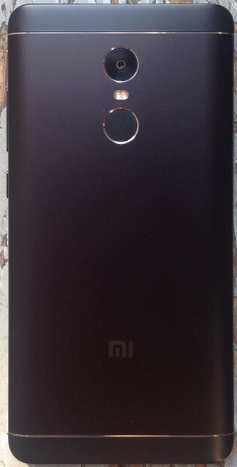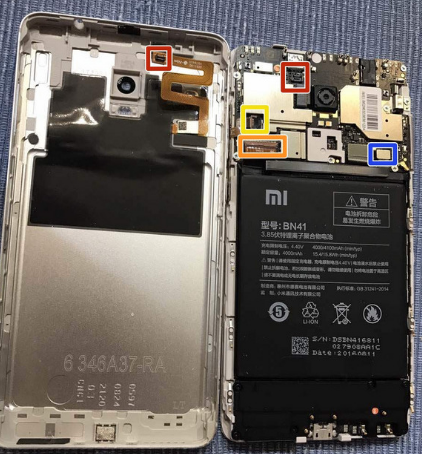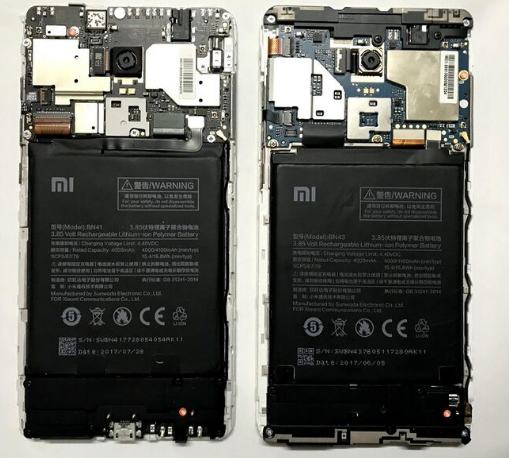
| Version | Summary | Created by | Modification | Content Size | Created at | Operation |
|---|---|---|---|---|---|---|
| 1 | Jason Zhu | -- | 1108 | 2022-10-26 01:49:53 |
Video Upload Options
The Xiaomi Redmi Note 4 is the fourth smartphone of Redmi Note series developed by Xiaomi Inc. It is a part of Xiaomi's budget Redmi smartphone line. It has two variants: The older version sold as Redmi Note 4 is powered by a Deca-core Mediatek MT6797 Helio X20 SOC. The upgraded version, sold both as Redmi Note 4X and Redmi Note 4 (where MTK version was not released) is powered by an Octa-core MSM8953 Qualcomm Snapdragon 625 SoC. The Redmi Note 4 was succeeded by Redmi Note 5.
1. History
In January 2017, the Snapdragon version of the Xiaomi Redmi Note 4X became the company's first major launch. It came with 2GB RAM + 32GB eMMC, 3GB RAM + 16 or 32GB eMMC and 4GB RAM + 64GB eMMC variants. The phone sports a 5.5-inch Full HD IPS display – the 1080 x 1920 resolution translating to a pixel density of 401ppi.[1] The display also promises to have contrast ratio of 1000:1 and 72% coverage of NTSC colour gamut.[2]
On February the 14th 2017, alongside the Chinese release of the Redmi Note 4X, Xiaomi released a limited edition set of the phone featuring Hatsune Miku. The set contained a customized box, the phone, a power bank and a protective case.
In October 2017, Lei Jun announced that the sales of Redmi Note 4X exceeded 20 million units globally and its reputation was good.[3]
The company announced that as many as 9,624,110 units of Redmi Note 4 were sold in India in 2017 and that it was one of their best selling smartphones in the last quarter of 2017.[4]
The device sold over 10 Million units in India alone.[5]
2. Specifications
2.1. Hardware
Xiaomi Redmi Note 4(MTK - codename nikel) is equipped with MediaTek MT6796 Helio X20 CPU and Mali-T880 MP4 GPU. It runs MIUI 8, (updated to MIUI 9.6) based on Android 6.0 . The Global 4X variant (SD - codename mido) uses Qualcomm's Octa-core 2.0 GHz Snapdragon 625 CPU and Adreno 506 GPU. It runs MIUI 8, (updated to MIUI 10.2) based on Android 6.0 later updated to Android 7.0. All variants include a 5.5 in (140 mm) 1080p display, 2 GB, 3 GB or 4 GB of RAM, 16 GB, 32 GB or 64 GB eMMC 5.1 Flash storage, a 5MP front camera, non-removable 4100 mAh Li-Po battery and it supports Wi-Fi 802.11a/b/g/n/ac* (* = Wi-Fi 802.11 ac band is supported on MTK variant only) networks on both the 2.4 and 5 GHz bands. Phones also support hybrid SIM and Memory Card configuration in which user can have either two SIM cards or a SIM card + microSDHC card at one time because one SIM card and the microSDHC card share the same physical tray slot.
Another notable feature of the phone is the presence of a fingerprint sensor at the back which can also be used for capturing images via the front or the rear cameras. The device also comes equipped with a RGB Notification LED light and is recognized as one of the last phones by Xiaomi to have an RGB light instead of the monochromatic White color notification LED used in devices launched thereafter.
The Redmi Note 4(MTK) has screws beside the microUSB port which allows easy access to internal components. The Redmi Note 4X does not have these set of screws.
Also, Redmi Note 4(MTK) have a full metal body whereas Global and Snapdragon variant of the phone have anodized aluminum body with plastic inserts at top and bottom for better signal reception. The global variant also misses diamond cut finish found on Mediatek variant of the phone.
2.2. Software
On launch, it ran MIUI 8 based on Android 6.0, which was updated to MIUI 10.2 based on Android 7.0 for Snapdragon devices. The Mediatek edition however, runs on MIUI 10 based on Android 6.0. Purchasing a Redmi Note 4 Snapdragon variant now will be running MIUI 8 based on Android 6.0.1 instead of Android 6.0. The Global Snapdragon Edition of the device is slated to receive MIUI 11 update based on Android 7.0 in November 2019.
3. Variants Comparison
| Name | Codename | Display | Resolution | Release date | SoC | RAM | User memory | LTE | Camera | Front camera | Battery | Operating system | MIUI distributions |
|---|---|---|---|---|---|---|---|---|---|---|---|---|---|
| Redmi Note 4 [6] | nikel | IPS 5.5" | HD 1080p | August 2016 | Mediatek
Helio X20 2 x 2.1 GHz + 4 x 1.85 GHz + 4 x 1.4 GHz |
3 GB | 32 GB | Yes | 13 MP | 5 MP | 4100 mAh
(typical)/4000 mAh (minimal) |
MIUI 10
Android 6.0 MIUI 8 when released |
China, Global and Xiaomi.eu |
| 64 GB | |||||||||||||
| 4 GB | 64 GB | China | |||||||||||
| Redmi Note 4X [7]
Redmi Note 4[8] |
mido | January 2017 | Qualcomm
Snapdragon 625 8 x 2.0 GHz |
2 or 3 GB | 16 GB | MIUI 11
Android 7.0 MIUI 8 based on Android 6.0.1 when released |
China, Global and Xiaomi.eu | ||||||
| 32 GB | |||||||||||||
| 4 GB | 64 GB | Global and Xiaomi.eu |
4. Reception
The smartphone received mostly positive feedback upon its launch because of its great battery life, good thermal performance, great price-to-performance ratio and great day to day performance.
GSMArena states: "The Redmi Note 4(X)'s Snapdragon 625, which we consider to be the ultimate mid-range chipset for this generation, provides excellent performance with great power efficiency and thermal properties. The battery life of this phone is jaw-dropping, the MIUI experience is smooth, and the camera does well in all occasions. All these goodies come in a sturdy metal body, which adds to the already great value of the Redmi Note 4(X)." Also, in GSMArena's device review, the Snapdragon edition of the phone scored much better than specified figures, getting 1500:1 Contrast ratio, 484nits of maximum luminance and excellent colour accuracy for the class.[1] [9]
According to AndroidAuthority: "The Redmi Note 4(X) is not perfect, but it is a well-rounded package that one wouldn’t hesitate to recommend to anyone looking for a budget or mid-range smartphone. Packed in a neat chassis, the smartphone performs great and is a compelling value-for-money smartphone." [10]
Gadgets360 also rated the phone 8 on 10, appreciating the device for its battery efficiency, good performance for the class and good thermal efficiency.[11]
AndroidCentral also considered Redmi Note 4(SD variant) to be one of the best smartphones one can buy in mid-budget range even after 6 months of launch.[12]
TechRadar called Redmi Note 4 to be an overall impressive device overall, though lacking the X factor, getting 4/5 ratings.[13]
Initially upon launch, it was not received as the true successor of the Redmi Note 3(Snapdragon Variant) mostly because of the use of Snapdragon 625 as opposed to the Snapdragon 650 in Redmi Note 3 in terms of the RAW performance of the CPU and GPU. Though perceived initially as a theoretical downgrade by media, XDA Developers also considered the device an upgrade to Redmi Note 3, citing its overall sustained performance, on par day to day performance and better battery and thermal performance by a good margin.[14][15] The new Snapdragon 625 was well received by users as well as reviewers after using the device for a while owing to better fabrication process, battery life and thermal efficiency of the new chipset over the Snapdragon 650.
5. Gallery
-

Back of gold Redmi Note 4X
-

Back of black Redmi Note 4X
-

Inside of Redmi Note 4
-

Insides of Redmi Note 4(X) MTK Version (Left) and Qcom Version (Right)
References
- "Xiaomi Redmi Note 4 review". 2017-02-17. http://www.androidauthority.com/xiaomi-redmi-note-4-review-749774/.
- "Xiaomi Redmi Note 4 Price and Features - Mi India". https://www.mi.com/in/note4/.
- ""价格屠夫"名不虚传!红米NOTE4X:单机销量突破2000万". https://share.iclient.ifeng.com/shareNews?fromType=vampire&aid=sub_32413967.
- "Xiaomi sold more than 9.6 million Redmi note 4 last year". Times Now,edited by Suraj Sarkar 1805. http://www.timesnownews.com/technology-science/article/xiaomi-sold-96-lakh-redmi-note-4-units-in-india-q4-2017/198584.
- Jain, Manu Kumar (2018-11-20). "#RedmiNote4: 10M phones sold in one year! #MIUI10 stable ROM is now available for Redmi Note 4. Check out: https://in.c.mi.com/thread-1663267-1-0.html … Excited that tomorrow we are launching #RedmiNote6Pro, the 1st phone from Xiaomi with Quad (4) Cameras . #Xiaomi #RedmiNoteLegacypic.twitter.com/96fDSyFI96" (in en). https://twitter.com/manukumarjain/status/1065103055765430273.
- "红米Note 4 参数 - 小米商城" (in zh-CN). http://www.mi.com/redminote4/specs/.
- "红米Note 4X - 小米商城" (in zh-CN). https://www.mi.com/redminote4x/.
- "Redmi Note 4 - Mi Singapore" (in English). http://www.mi.com/sg/note4/.
- "Xiaomi Redmi Note 4 (S625) review: Take Note!" (in English). GSMArena.com. http://www.gsmarena.com/xiaomi_redmi_note_4_snapdragon-review-1593p9.php.
- Xiaomi Redmi Note 4 review, by Abhishek Baxi, February 17, 2017, androidauthority.com http://www.androidauthority.com/xiaomi-redmi-note-4-review-749774/
- Pratap, Ketan. "Xiaomi Redmi Note 4 Review" (in en). https://gadgets.ndtv.com/mobiles/reviews/xiaomi-redmi-note-4-review-1650455.
- "Xiaomi Redmi Note 4 review: Six months later" (in en). 2017-07-25. https://www.androidcentral.com/xiaomi-redmi-note-4-review-six-months-later.
- "Redmi Note 4 Review". https://www.techradar.com/reviews/xiaomi-redmi-note-4-review.
- "Xiaomi Redmi Note 4 XDA Review: All Geared Up for Another Year of Success" (in en-US). 2017-03-18. https://www.xda-developers.com/xiaomi-redmi-note-4-xda-review-in-depth/.
- "Xiaomi Redmi Note 4 XDA Performance and Battery Life Review (Compared to Redmi Note 3)" (in en-US). 2017-02-19. https://www.xda-developers.com/redmi-note-4-xda-review/.




